Museum Fodor
Museum Fodor (Dutch pronunciation: [myˈzeːjɵm ˈfoːdɔr]) is a former art museum in Amsterdam in the Netherlands. The museum was located at the Keizersgracht in Amsterdam-Centrum in the building that currently houses the Foam Fotografiemuseum Amsterdam.[1][2]
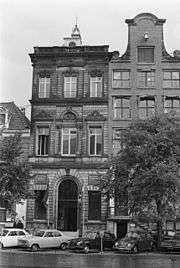 Museum Fodor in 1970 | |
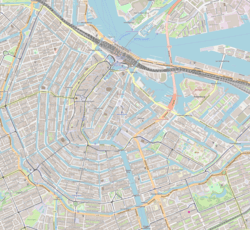 Location in the city center of Amsterdam | |
| Established | 1863[1] |
|---|---|
| Dissolved | 1 January 1993[1] |
| Location | Keizersgracht 609[1] Amsterdam, Netherlands |
| Coordinates | 52°21′50″N 4°53′37″E |
| Type | Art museum[1] |
| Founder | Carel Joseph Fodor[1] |
The museum was opened in 1863. It was founded following the death of Carel Joseph Fodor and displayed his art collection. The museum was dissolved in 1993.[1] Fodor's collection is now managed by the Amsterdam Museum.[3]
History
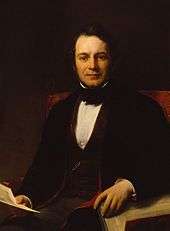
The monumental building on the Keizersgracht canal has a history going back to Carel Joseph Fodor (1801–1860), who worked in the coal trading business. Carel Fodor first bought the Keizersgracht 611. Later he also bought the adjacent warehouse and residential house.
Fodor started to collect paintings, drawings and prints from 1834 onwards. His preference went out to contemporary art, works by 'living masters'. Fodor quickly opened up his house to the general public, where many art lovers visited to see his collection by appointment.
When Fodor died, he bequeathed his collection to the city of Amsterdam. He also left behind a large sum of money to turn his house into a museum. Fodor destined Keizersgracht 609, the warehouse, in his testament as the exhibition space that should receive the name Museum Fodor. It should become a permanent exhibition space for his personal collection.
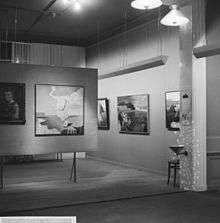
The building was renovated in 1861 by Cornelis Outshoorn. In 1863, Museum Fodor opened its doors as the first museum of modern art. In the early years the museum attracted a large number of visitors, but as the years passed by these numbers dwindled.
In 1948 the collection was stored in a depot and the museum became a separate location of the Stedelijk Museum. In 1963 the complete collection was taken over by the Amsterdams Historisch Museum.
Museum Fodor was dissolved on 1 January 1993.[1]
Building
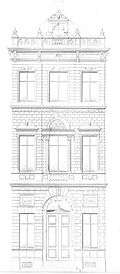

Museum Fodor was located at Keizersgracht 609 near the Leidsestraat in the center of the canal district in the borough Amsterdam-Centrum.[4]
The museum building was originally a canal-side warehouse.[4] In 1860, it was owned by Carel Joseph Fodor.[1] In 1861–62, after Fodor's death, the building was turned into a museum by a design of architect Cornelis Outshoorn. The building was elevated with an Italianate facade, made of sandstone, with a straight cornice.[4]
The building has been a rijksmonument (national heritage site) since 1970.[4]
From 1994 to 2001, the Dutch Design Institute was housed in the building. Since 2001, the Foam Fotografiemuseum Amsterdam is located here.[3]
Collection
The collection of Museum Fodor consisted of the large collection of paintings, prints, and drawings that Carel Joseph Fodor bequeathed to the city of Amsterdam.[1] Among the paintings was Christus Consolator (1837) by Ary Scheffer, which Fodor had bought from the collection of the Duchess of Orléans.[5] The museum acquired the Atlas Splitgerber in 1879 and a collection of works by Jan and Caspar Luyken in 1889.[1]
From 1948, the collection was no longer on display in Museum Fodor. The paintings were moved to the Stedelijk Museum Amsterdam, the prints and drawings to the Rijksmuseum and the Atlas Splitgerber to the Amsterdam City Archives.[1] Since 1963, Fodor's collection is managed by the Amsterdams Historisch Museum.[3]
 Christus Consolator (1837) by Ary Scheffer
Christus Consolator (1837) by Ary Scheffer Resting sheep with lamb (1840) by Eugène Joseph Verboeckhoven
Resting sheep with lamb (1840) by Eugène Joseph Verboeckhoven Sawmill at a frozen canal (1842) by Andreas Schelfhout
Sawmill at a frozen canal (1842) by Andreas Schelfhout Turkish school (1846) by Alexandre-Gabriel Decamps
Turkish school (1846) by Alexandre-Gabriel Decamps Nymph with cupidos (1851) by Narcisse Virgilio Díaz
Nymph with cupidos (1851) by Narcisse Virgilio Díaz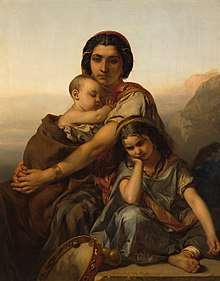 Gypsy woman with two children (1852) by Louis Gallait
Gypsy woman with two children (1852) by Louis Gallait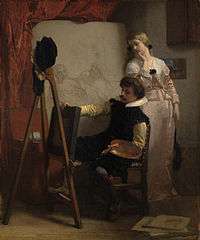 Painter behind his easel shows a painting to a girl (1852) by Florent Joseph Marie Willems
Painter behind his easel shows a painting to a girl (1852) by Florent Joseph Marie Willems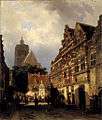 View on the Wellerondom in Den Briel (1856) by Cornelis Springer
View on the Wellerondom in Den Briel (1856) by Cornelis Springer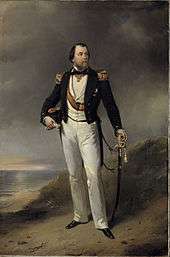 Portrait of William III (1859) by Nicolaas Pieneman
Portrait of William III (1859) by Nicolaas Pieneman Zeelandic waters in quiet weather (1860) by Andreas Schelfhout
Zeelandic waters in quiet weather (1860) by Andreas Schelfhout
References
- (in Dutch) 5446: Archief van het Museum Fodor Archived 2012-12-20 at Archive.today, Amsterdam City Archives. Retrieved on 9 August 2014.
- Foam Archived 2014-08-12 at the Wayback Machine, I amsterdam. Retrieved on 10 August 2014.
- Yvonne Prins, "Carel Fodor en Debora Blok", Ons Amsterdam, 2002. Retrieved on 11 August 2014.
- (in Dutch) Monumentnummer: 2390, Rijksdienst voor het Cultureel Erfgoed. Retrieved on 11 August 2014.
- (in Dutch) A. J. A. Flament, "Fodor (Carel Joseph)", Nieuw Nederlandsch Biografisch Woordenboek, 1974. Retrieved on 11 August 2014.
External links
| Dutch Rijksmonument 2390 |

- Museum Fodor/FOAM with photos (Dutch)
- Wessel Krul (November 2009). "Collecting for posterity: Two Dutch art collectors in the nineteenth century and their bequests to the nation". Journal of the History of Collections. 21.
